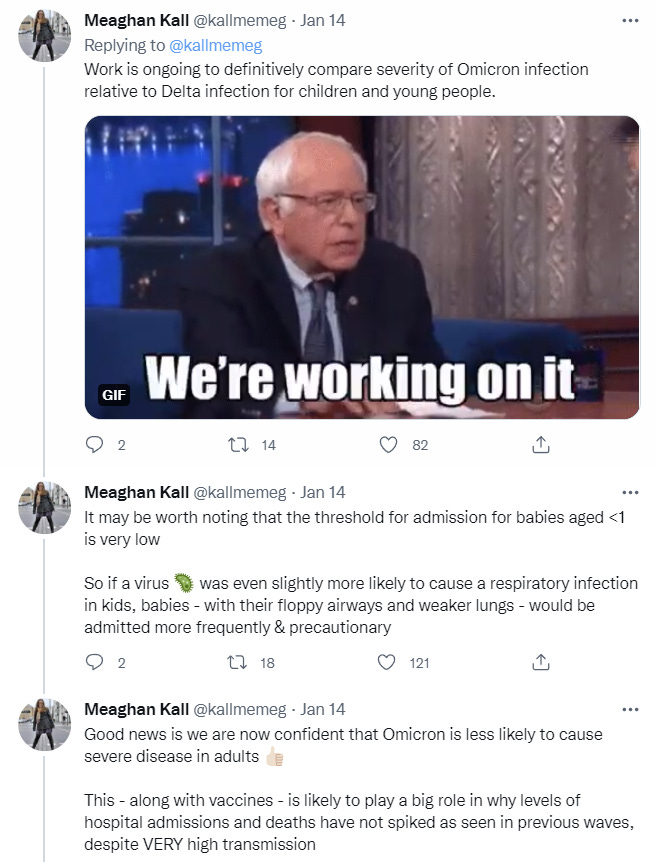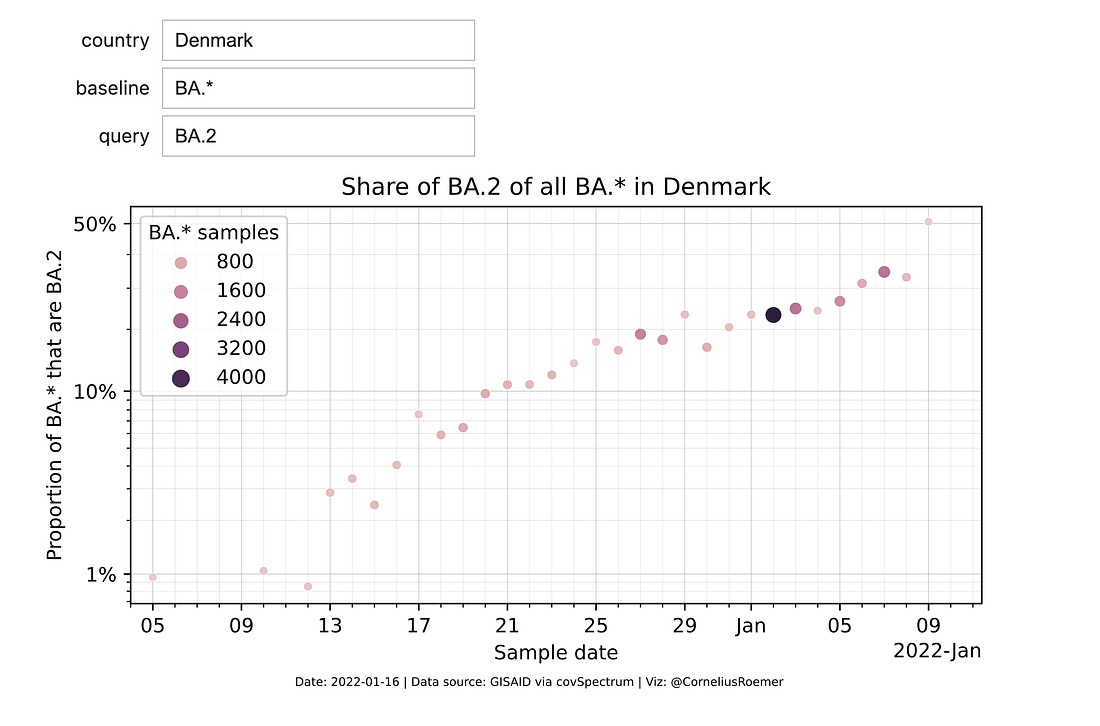Omicron has fully taken over, and our uncertainty about it has mostly been resolved. The Omicron pandemic is now the Covid-19 pandemic, and we’re back in a kind of ‘normal mode’ albeit at the top of the Omicron wave.
A few weeks ago, the majority of the information and week’s discussion were in the Omicron posts. This week, the vast majority are in the normal weekly post, there’s only one pure Omicron post (although the Polymarket post was closely related) and it’s relatively short.
Going forward, after this week, my default plan is to incorporate the Omicron news and the Omicron-related predictions into the mainline weekly posts, and supplement with issue-specific posts rather than general Omicron updates.
If things continue to go well, I hope to use the resulting bandwidth to start doing less speed premium writing, and more longer term analysis, both on Covid and otherwise. There’s a lot I simply haven’t had the time to think about let alone write out properly.
Remember, this is a happy moment. We are no longer in (as much of) an emergency.
Severity
Thread updating what we know about severity of Omicron. Less severe in adults, less loss of taste and smell, mostly this is confirmation of the usual good news.
The issue of severity in children is less clear because Covid-19 is so non-severe in children it’s hard to tell the relative change.


All we know is there’s a lot more cases, and a lot more cases means a lot more child cases, and a lot more ‘with Covid’ cases means proportionally more child cases, and none of that is particular reason to doubt that the severity effect in children is different from that in adults, but we don’t know for sure because we lack the data, which results in for example the UK’s report saying about severity in children we have ‘low confidence.’ I agree that we are less confident here, but our baseline should mostly be that it roughly matches the adult changes, rather than a baseline of no change from Delta. But even if there is no change from Delta, that’s still not high risk.
Spread
BA.2 is the other sub-variant of Omicron, whereas BA.1 is the one that shows up on S-gene deletion tests and it most common in the USA and UK. This thread discusses whether we should worry about BA.2, and offers this chart, you can get more at this website.

If we take this at face value, it was 10% of Omicron cases on 21 December, and is about 30% of Omicron cases on 8 January, which is about two doublings in three weeks. Even with fast generations that edge is substantial, and is one reason to expect this to blunt downward trends somewhat, but the rates of decline of BA.1 are faster than this in places where BA.1 is declining, so this is unlikely to be additionally scary in those areas. If BA.2 ‘gets there first’ in a given area, it would lead to a higher peak, and it makes containment by China potentially that much harder.
Wastewater surveillance is available in a few places other than Boston so here’s some data from California.


Whereas Boston continues to be a straight line rapidly dropping down (interesting note is that the ratio of north Boston to south Boston doesn’t seem very constant?), the California data represents a gentle peak that doesn’t seem to be continuing to drop, in a way that doesn’t have an obvious physical explanation. I’m not sure what to make of it.
A basic but well-executed thread from Bob Wachter that spells out how much Covid is out there right now, and thus how much less risky activity will soon become. The difference will be extreme, although I’m not convinced it will be quite this extreme.

That’s a factor of 50, a 98% decline in relative risk of a given activity (e.g. microCovids), within a month. I’d be surprised if we get a 98% decline within a month, but I’d be highly unsurprised by 90%, and even more surprised by “only” 70% declines from peak (in actual infections) than I would be by 98%. We will never know the true number.
Some anecdata offered in the comments from an unmasked dance party.
As promised, Remolino policy towards COVID-19 will be full disclosure of all information. Therefore – there were 82 infections among a total of 509 Remolino participants.
Of those:
– 7 infections among 10 elves;
– 6 infections out of 21 DJs;
– 3 tests came positive from the lab out of 41 PCR and 145 antigen;
– 2065 self tests were distributed altogether;
– 12 people could not come to the festival because they got infected a week preceding or during the festival, and 4 people had Covid just before the festival, but came after recovering;
– 113 people canceled before or during the festival before arriving to Lviv, 7 people left earlier than registered for;
– of all infected, 62 had first positive test only after they arrived back home;
– among all participants, 11 have not had vaccine or confirmed previous infection;
– we have a confirmation of Omicron from at least one sequenced specimen
The NBA Covid index, which continues to be our most reliable, says we’ve peaked.

Note that it doesn’t mean we were already down by that much by the 14th, the NBA tends to be somewhat ahead of the curve so they’ll peak somewhat earlier, but you can tell how much earlier by looking at the graph.
Evidence from Japan says Omicron cases continue shedding virus for longer.
Scott Gottlieb is skeptical that China can contain Omicron, despite doing things like killing all the hamsters in Hong Kong.
Prediction Updates
China keeps daily cases under 50 per million through 2022: 30% (unchanged).
On the one hand, Gottlieb is skeptical, although it’s hard to translate that into his probability since he doesn’t talk in those terms. On the other hand, killing all the hamsters is a costly signal of seriousness, even if it’s not a very effective countermeasure. I’m roughly unchanged for now, and this is long enough term that the time lapse doesn’t carry much weight yet either.
Median peak cases day for United States: January 19 → January 15 (but only ~70% to have already happened, with most of the rest being later this week, if we’re going by measured cases, delisting but not evaluating yet)
Mode peak cases day for United States: January 19 → January 15 (delisting but not evaluating yet)
Daily cases in the the United States have peaked by February 1: 90% → 98% (delisting).
If we use OurWorldInData as our canonical source here, it looks like the peak already happened on January 15. That’s definitely the mode day. The question is whether the holiday backlog will cause us to bump above it before heading back down. Week over week cases (from Jan 13 to Jan 20) are looking very close to flat on Wikipedia chart, which is consistent with a mid-week peak.
Either way, the peak in reality (without removing lag times) was sometime between January 15 and January 20, which means with lag times it was several days before that. Delisting and evaluating the peak in January to true, will evaluate the mode and median as soon as we know the exact date but not going to update them further.
Will There Be a Federal Mask Requirement on Domestic Flights as of November 8, 2022? 45% → 44%.
There’s a market now at Polymarket, and it’s now at 43% so adjusting slightly.
Chance that Omicron has a 100% or bigger transmission advantage in practice versus Delta: 45% (unchanged).
I’m considering this to be about BA.1 rather than BA.2 and I still think the math is close. I’m going to stop updating it unless we learn more, because I don’t expect us to ever truly know, and conclude that it’s something relatively close to this.
Chance that Omicron is importantly (25%+ in the same person) less virulent than Delta: 97% → 98% (delisting).
Evidence keeps piling up, suspending this prediction unless number goes down and evaluating to true, leaving the 2% for model error.
Chance that Omicron is vastly (75%+ in the same person) less virulent than Delta: 30% → 40%.
The death numbers in the United States are not going up. There’s all these reports of hospital cases not matching the paths we see in Europe, but the death number this week looks like it’s not going to have gone up. It’s going to be about the same, causing my prediction to miss, and I need to adjust for that.
Chance we will be getting boosters modified for Omicron within 6 months of our previous booster shot: 20% → 15%.
Chance we are broadly looking at a future crisis situation with widely overwhelmed American hospitals, new large American lockdowns and things like that: 2% → 1% (delisting).
Omicron is already on the decline, or at worst will be on the decline within the week. By the time the boosters arrive in March, I don’t see any reason to be pushing an additional booster on anyone who was already recently boosted outside of the highest-risk groups, and I don’t consider that to count on its own, but our elites can get crazy about such things, so I can’t fully rule it out and there’s no market.
On the crisis, the answer is no, not unless something crazy and highly unexpected happens, and most of the crisis situations that happen in 2022 are caused by things other than Omicron. I’m delisting and evaluating to false.
That’s a lot of delisting probabilities. I plan to add some of the Polymarket markets to replace them, but I already dealt with that on Monday, so not going to duplicate it now since little has changed since then.
Suggestions for additional markets and predictions are always welcome.